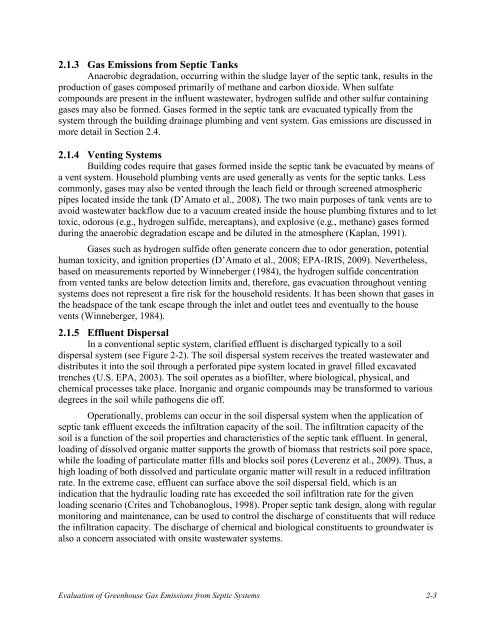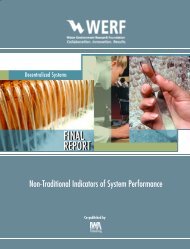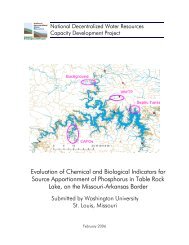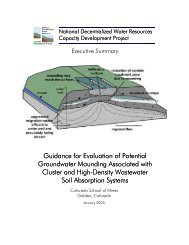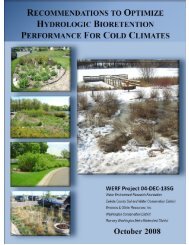Evaluation of Greenhouse Gas Emissions from Septic ... - Geoflow
Evaluation of Greenhouse Gas Emissions from Septic ... - Geoflow
Evaluation of Greenhouse Gas Emissions from Septic ... - Geoflow
Create successful ePaper yourself
Turn your PDF publications into a flip-book with our unique Google optimized e-Paper software.
2.1.3 <strong>Gas</strong> <strong>Emissions</strong> <strong>from</strong> <strong>Septic</strong> TanksAnaerobic degradation, occurring within the sludge layer <strong>of</strong> the septic tank, results in theproduction <strong>of</strong> gases composed primarily <strong>of</strong> methane and carbon dioxide. When sulfatecompounds are present in the influent wastewater, hydrogen sulfide and other sulfur containinggases may also be formed. <strong>Gas</strong>es formed in the septic tank are evacuated typically <strong>from</strong> thesystem through the building drainage plumbing and vent system. <strong>Gas</strong> emissions are discussed inmore detail in Section 2.4.2.1.4 Venting SystemsBuilding codes require that gases formed inside the septic tank be evacuated by means <strong>of</strong>a vent system. Household plumbing vents are used generally as vents for the septic tanks. Lesscommonly, gases may also be vented through the leach field or through screened atmosphericpipes located inside the tank (D’Amato et al., 2008). The two main purposes <strong>of</strong> tank vents are toavoid wastewater backflow due to a vacuum created inside the house plumbing fixtures and to lettoxic, odorous (e.g., hydrogen sulfide, mercaptans), and explosive (e.g., methane) gases formedduring the anaerobic degradation escape and be diluted in the atmosphere (Kaplan, 1991).<strong>Gas</strong>es such as hydrogen sulfide <strong>of</strong>ten generate concern due to odor generation, potentialhuman toxicity, and ignition properties (D’Amato et al., 2008; EPA-IRIS, 2009). Nevertheless,based on measurements reported by Winneberger (1984), the hydrogen sulfide concentration<strong>from</strong> vented tanks are below detection limits and, therefore, gas evacuation throughout ventingsystems does not represent a fire risk for the household residents. It has been shown that gases inthe headspace <strong>of</strong> the tank escape through the inlet and outlet tees and eventually to the housevents (Winneberger, 1984).2.1.5 Effluent DispersalIn a conventional septic system, clarified effluent is discharged typically to a soildispersal system (see Figure 2-2). The soil dispersal system receives the treated wastewater anddistributes it into the soil through a perforated pipe system located in gravel filled excavatedtrenches (U.S. EPA, 2003). The soil operates as a bi<strong>of</strong>ilter, where biological, physical, andchemical processes take place. Inorganic and organic compounds may be transformed to variousdegrees in the soil while pathogens die <strong>of</strong>f.Operationally, problems can occur in the soil dispersal system when the application <strong>of</strong>septic tank effluent exceeds the infiltration capacity <strong>of</strong> the soil. The infiltration capacity <strong>of</strong> thesoil is a function <strong>of</strong> the soil properties and characteristics <strong>of</strong> the septic tank effluent. In general,loading <strong>of</strong> dissolved organic matter supports the growth <strong>of</strong> biomass that restricts soil pore space,while the loading <strong>of</strong> particulate matter fills and blocks soil pores (Leverenz et al., 2009). Thus, ahigh loading <strong>of</strong> both dissolved and particulate organic matter will result in a reduced infiltrationrate. In the extreme case, effluent can surface above the soil dispersal field, which is anindication that the hydraulic loading rate has exceeded the soil infiltration rate for the givenloading scenario (Crites and Tchobanoglous, 1998). Proper septic tank design, along with regularmonitoring and maintenance, can be used to control the discharge <strong>of</strong> constituents that will reducethe infiltration capacity. The discharge <strong>of</strong> chemical and biological constituents to groundwater isalso a concern associated with onsite wastewater systems.<strong>Evaluation</strong> <strong>of</strong> <strong>Greenhouse</strong> <strong>Gas</strong> <strong>Emissions</strong> <strong>from</strong> <strong>Septic</strong> Systems 2-3


